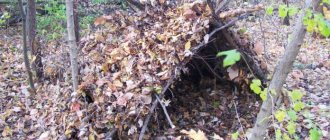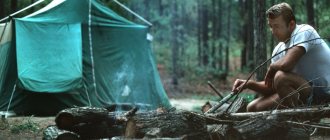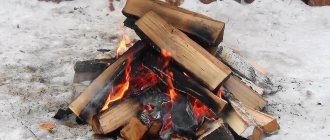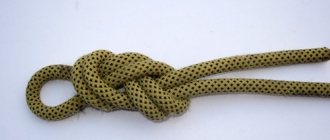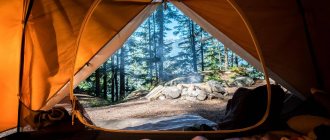Choosing a place for a fire is not a difficult task, but it is always mandatory. An incorrectly chosen place for a fire in some cases can simply cause inconvenience, for example, smoke flying towards the overnight stay is unlikely to provide a comfortable sleep, and in others it threatens the traveler with big problems, for example, a forest fire.
The almost optimal place for a fire is not far from the water, among the stones, at a distance from a young pine forest.
In this article, we will look at the basic rules for choosing a place for a fire for different conditions, for example, deep snow, swampy areas, as well as options for organizing a fire in unfavorable weather.
Basic rules for choosing a place for a fire
Following simple rules will allow you to avoid many of the troubles associated with starting a fire in a camp outdoors.
These rules include the following:
- You cannot burn a fire under trees. If the tree is dry, it may catch fire, and if it is alive, its roots may be damaged. Usually, to comply with this rule, it is enough to light a fire at a distance of 5 meters from the tree trunk or more. But in rare cases, this rule can be neglected, for example, if in a war zone it is necessary to hide a fire from a flying enemy aircraft.
- Do not light a fire near thickets of dry grass and bushes. Even a small spark flying from the fire can be enough to start a fire.
- You cannot make a fire in the thickets of young pine trees. This, by the way, is one of the rules prescribed by law.
- You cannot make a fire on peat bogs, because peat is a good flammable material that can easily be set on fire and smolder for a long time, emitting acrid smoke. If an urgent need arises, you can also burn on peat bogs, having first poured a thick layer of sand on the site of the future fire, but this is also unsafe. Among other things, failure to comply with this rule may result in administrative penalties in the form of a fine.
- It is forbidden to light a fire in logging areas, provided there is wood debris present. Such debris can easily ignite, causing a serious fire.
- If you plan to burn the fire more than once, you should not place it on the shore too close to a body of water, since the next rise in the water level (high water in the river or high tide in the sea) can not only extinguish, but also wash away the fire.
- The area under the fire must be cleared of dry leaves and other flammable materials. If this is not done, the fire can easily spread throughout the entire area.
- If possible, it is better to dig around the perimeter of the place for the future fire. To ensure fire safety, the thickness of the circumference of the dug area must be at least 0.5 meters, but it all depends on the size of the fire that is planned to be lit. If digging around the perimeter is not possible or difficult, you can line it with stones or cover it with a thick layer of sand.
- It is undesirable to make a fire from spruce and fir, as their wood often shoots sparks and can burn things, a tent, and sometimes lead to a fire.
Fire in a young pine forest.
For reference
Peat is compressed, half-decomposed swamp vegetation.
The drainage of peat bogs led to the appearance of dry areas on the surface covered with this substance.
Extinguishing peat fires is a very difficult process, since peat, due to its resinous substances, does not allow water to normally seep into its inner layers. In addition, peat is capable of spontaneous combustion due to heating as a result of the work of microorganisms, so in drained peat bogs you should be extremely careful and try to avoid starting a fire altogether.
Fire on a peat bog.
Among other things, in each country and even region there may be bills, different from similar ones in other territories, prohibiting, at a certain period, lighting open fires in forest or steppe zones or in certain areas thereof. As a rule, burning fires is prohibited in the territories of nature reserves, regardless of the region.
Therefore, before going on a hike or going on a picnic with barbecue, it is advisable to ask the forestry department or other authorities related to environmental protection, where it is allowed to burn fires in a particular area.
Of course, such laws are of the utmost importance for a person surviving in the wild, but for a tourist, fisherman and hunter they will save their finances and nerves. Also, before a hiking trip, you should definitely familiarize yourself with them and find out where you can and where you can’t light fires on the planned route.
From all of the above, we can draw conclusions about the optimal place for a fire, which are easier to navigate when planning to start a fire in the wild.
Design of the area near the fireplace
In order to decorate the area near the fireplace, you can use pebbles, gravel or tiles for garden paths. If you expand the area near the fireplace, you will get an excellent area for a good rest. An interesting option are flat slabs of irregular geometric shapes, which are laid out in a bizarre pattern. These wide slabs can easily accommodate chairs, benches, or other various garden furniture. An ideal option for arranging a fire pit in a country house would be a circular bench with backs. To give such a platform comfort and coziness, the platform can be decorated with rugs, and decorative pillows and blankets can be placed on the bench.
The same material that was used to decorate the hearth can be used to make a supporting wall; it will also serve as a backrest for the bench. In order to avoid having to go far for firewood, a special firewood shed is installed next to the fireplace, which is decorated in the same style as the hearth.
You can lay out a garden path to the fireplace, along which you can install small street lights. This will make the area cozy in the evening and create a special romantic atmosphere.
Often the area around the fire is made in the shape of the sun, and improvised sun rays are painted on the lining. It would be interesting to look at a summer cottage with a hearth made in the form of a lunar crater or fireplace, next to which you can install a small figurine of a guardian cricket.
An interesting idea for decorating a fire pit in a country house
Decorating a place near a fire in the country is not so difficult. The main conditions for work are the availability of all the necessary building materials, clear calculations, free time, imagination and a little creativity.
How to choose a place for a fire in the parking lot and in the camp?
For a comfortable and safe holiday, you can choose a place for a fire, guided by the following rules:
- The fire should be lit away from trees. Compliance with this rule will protect the forest from fire, and the tourist from fines and burns. Among other things, if you light a fire in a winter forest under trees, water from melted snow may flow from them into the fire, or it may happen that a whole lump of snow falls from a spruce branch into the fire, extinguishing it;
- A safe place is a flat rocky area, located away from dry vegetation, such as reeds;
- If there is a body of water near the camp (tourists usually try to camp in such places), this is very good: in this case the water can be used both to extinguish the fire itself and to extinguish a fire if one suddenly arises;
- It is advisable to choose a dry area for the fire. If this is not done, it will be more difficult to start a fire due to the moisture entering it with the air;
- It is advisable that there is a natural wind barrier near the site, for example, a rock or a large fallen tree. Such a “wall” will not only protect the fire from the wind, but also serve as a screen that reflects infrared radiation from the fire onto people and additionally warms them;
- If there is already an old fire pit near the chosen place - a place where a fire has already been burned, or a specially equipped place for making a fire made of brick or other materials, then it is better to burn a fire on it, unless this place does not contradict the basic rules of fire safety. This will reduce the harmful impact on nature and reduce the likelihood of a fire;
- The size of the fire pit and the distance from it to the tent should be chosen based on the size and type of the fire itself, as well as whether “shooting” wood will be used or not. Usually, from most fires, for example, from a hut and taiga, it is enough to put up tents at a distance of 3-5 meters, but if you plan to spend the winter night in a lean-to hut with heating from a node, then the distance here needs to be selected experimentally, otherwise the heat will not be enough for warming the body. The heating zone here depends both on the air temperature and on the quality of the screen arrangement for heat;
- The tent should be positioned in relation to the fire so that the wind carries sparks and smoke in the opposite direction. However, if you spend the night by the fire, the hut must be built near the node so that the wind blows from the side.
Another well-chosen place for a fire is on a high river bank, away from trees and in shallow snow.
Now let’s look at how to choose and arrange a place for a fire in difficult conditions.
Selecting and preparing a place for the fire
The initial requirements for a future fire pit must comply with existing fire safety standards. The future fireplace should be installed at a distance of at least 4 meters from trees and bushes. You should retreat 3 - 3.5 meters from residential buildings and utility structures.
Do not locate an area for open flames directly next to fences dividing land plots. Most likely, your neighbors won't find the smoke from the fire particularly pleasant. Do not locate the future fireplace on hills, on the windward side. And it would be completely unnecessary to arrange a place for an open flame near a warehouse for flammable substances, gas cylinders and household chemicals.
The flame zone should fit harmoniously into the design of the site, emphasizing the harmony of the country landscape. A recreation area is usually installed near the future fireplace - a small area paved with fire-resistant bricks, paving slabs or stone. Such a platform performs several main functions:
- decorates the recreation area with safe materials;
- prevents fire from spreading due to an accidental spark;
- serves as an ideal place for a holiday for the whole family.
The allocated place for the fire should be prepared - cut off the top layer of soil to a depth of 30 cm, level and compact the resulting area. This prepares the soil for laying elements of the recreation area.
Preparing a fire pit in deep snow
If we consider the situation in a winter snow-covered forest, then most fires, without preliminary preparation of the place for their lighting, will melt the snow and go to depth. In this case, the water from the melted snow will moisten the fire, and the resulting hole will reduce the access of oxygen, which can negatively affect combustion. Well, of course, a fire buried under the snow can no longer be considered as a source of heating, and cooking food on it, located 1.5 meters below the snow level, is also somehow not very convenient.
To avoid these inconveniences, there are several solutions:
- Excavate the fire pit down to the ground and expand it. This option is convenient for cooking and heating during the day in between other activities around the camp when there is a small layer of snow cover.
- If the depth of the snow cover is great (tested with a long straight stick stuck into the snow to the ground) and digging is impractical, you can make a deck for many fires from thick logs. This flooring should be wider than the fire itself. In this case, even if the fire melts the snow, it will only be in the central part, while the edges of the flooring will remain in the unheated areas, keeping the burning wood on the surface.
- Use types of fires that do not melt snow. For example, you can make a wooden primus stove with your own hands for cooking or a node from two logs for a comfortable overnight stay, and a taiga fire will help you both cook food and keep warm without making any special efforts.
The Finnish candle is a fire that requires very little space and does not fall into the snow.
If you plan to make a fire just to boil a mug of tea, then you can light it on a floor made of brushwood or pieces of tree bark. Such a fire will cope with its task before going into the depths.
How to equip a safe and environmentally friendly fire pit for multiple fires?
In order not to harm either yourself or the environment, and not to add hassle to the Emergency Situations Ministry workers, when making a fire pit it is enough to follow simple instructions and follow a number of simple rules.
Let's list them and briefly analyze each:
You should not light a fire on peat bogs, since, firstly, it is difficult to trace the beginning of a peat fire, and secondly, it is difficult to extinguish it
Thirdly, it can cause crown fires, taking the lives of those who find themselves in the forest along their path; I’m not talking about the damage that such fires cause to nature; It is necessary to clear the area at the site of the fire and nearby from flammable materials, which is especially important, for example, in a pine forest, where the entire forest floor consists of flammable pine needles, or in a summer steppe covered with dry vegetation; You should dig around the fire or make a fire pit out of stone or brick to avoid the fire spreading to dry vegetation. In the wild, this can be done simply by covering the fire with stones; It is often advisable to lay out the surface under the future fire from stone, so that nothing remains on the ground after the fire
However, for some types of fires this is not necessary: for example, a classic noya leaves no traces on the ground at all; If necessary, you should make a “screen”, for example, in the form of a fence made of sticks, or make a fire near a rock wall. Such a fire will provide more warmth to the person sitting in front of it. On the other hand, some types of fires, for example, a hunting fire, themselves shield heat due to their design, and some other types, for example, one of the variants of a wood stove, do not provide heat at all; If you plan to use the fire for cooking, you can drive wooden posts into the ground and place a long, even stick on them or hang a rope for the pots; To set up a permanent fire pit, it makes sense to make a canopy against precipitation; under the canopy, the fire will not be extinguished at the most inopportune moment; If there is an equipped place for a fire or a place with traces of a fire, it is better to light a fire in this place (if, of course, it meets the requirements of safety and convenience); In deep snow, it is better to make a buried fire pit by excavating the area to the ground, or build a wooden deck from parallel-laid logs so that the fire does not “drown” in a snowdrift. However, when using some types of fires, for example, taiga fires, there is no need for such actions: such a fire remains on the surface of the snow cover even after burning for a long time.
A fire on a log deck is a great way to avoid melting snow, causing the fire to sink, and scorching the ground.
Of course, in each specific case it is also necessary to take into account specific nuances that cannot be predicted in advance. For example, in a swampy area, you need to be able to choose a place for a fire pit so that it does not become flooded, and, for example, in a summer steppe, the entire fire pit must be cleared of dry grass in advance in order to prevent a steppe fire. These subtleties must be taken into account before starting a specific fire in a specific place.
Preparing a site for a fire in swampy areas and on water
In swampy areas, if you do not have a fire pit, starting a fire can be difficult.
To protect the fire from water, it can be done on the flooring. For this:
- Three spears break off. You can take four, but this is an extra waste of time. Horns are stuck into the bottom of the reservoir so that their “horns” rise above the water. If you look at the structure from above, the spears should be located in the shape of an equilateral triangle. When using four spears, a square should form.
- On three slingshots, two poles are placed in the gap between the “horns” so that on one of them the ends of two poles lie simultaneously, while on the other two slingshots - on one end of the other poles.
- A flooring of thin logs is placed on top of the poles, which it is advisable to cover with earth so that the logs do not quickly burn out. If there is no dry earth, and you plan to burn the fire later, you can spread a thick layer of dirt on the flooring: by the time the fire is lit, it will have time to drain a little and dry out. That's it - the fire pit is ready.
Also, for the same purposes, you can make a small raft and similarly cover it with a layer of earth that protects the structural elements from burning.
Fire pit in the middle of a swamp.
I know of other ways to protect fire from water, but they are either more complex or require additional materials that are not always at hand, so I see no point in talking about them.
How to protect a fire from the wind
Often, the wind helps to fan the fire and make it burn better, but it can also create some difficulties, for example, for cooking. Thus, in a strong wind, the flames can be blown away from the pot suspended over the fire, which leads to large expenditures of fuel, time and effort for cooking.
In this and other cases, when the influence of the wind needs to be reduced, you can create a wind barrier from available materials, for example, drive four sticks into the ground, between which lay branches cleared of leaves, or weave the sticks with thin brush according to the principle of weaving a basket. In permanent parking, the cracks in such a fence can be covered with clay if necessary.
Also suitable for these purposes is one of the types of fire in a pit, for example, a trench or a Dakota hearth, in which a wind barrier is provided by the design of the fire itself.
The Dakota hearth is a fire that is not afraid of the wind.
Well, and of course, natural shelter can be used as a wind barrier, as discussed in the rules for choosing the optimal place for a fire. In this case, the location of the fire is initially selected taking into account the direction of the wind.
Types of lesions
Hearth in the pit
To build such a fireplace, it is necessary to make a hole in the ground. To make the structure stronger, it is better to line the walls with brick. It is recommended to lay it vertically, i.e. with the side wall facing the fire. Please note that bricks take up additional space. Therefore, the pit should be made wider by the size of the brick belt. Around the fire pit you can line it with paving slabs. Tiles with chipped edges are also suitable for these purposes.
Brick street hearth
To build a fireplace out of brick, you will need fireproof bricks and mortar. A brick grill can be of any shape, but round hearths are the most popular. A fire grate is usually placed in the center of the structure. To construct this option, you will also need to dig a small hole.
Concrete hearth
Alternatively, an outdoor fireplace can be made of concrete. For this you will need formwork. It can be made from available materials, for example, boards, plywood, etc. It is necessary to dig a hole of a certain size, install the formwork and pour the concrete mixture. Once the concrete gains the required strength, the formwork is removed. As you know, concrete does not have a very presentable appearance. Simple cladding will add aesthetics to the building. Marble or granite tiles look great. Also, chipped stones and bricks are excellent for cladding.
Hearth made of natural stone
Most often, pure granite and marble are used to make hearths. The advantages of this option include excellent appearance and durability. A significant disadvantage is the high cost.
Fire table
Alternatively, a tabletop made of stone can be laid on top of a brick or concrete hearth. This design is called a fire table. A hole for the fire is made in the central part of the tabletop. Such an impromptu table with a barbecue is convenient for gatherings with family or friends.
Fireplace in the garden made of metal
You can make a simple metal hearth yourself; it is very reminiscent of a regular barbecue. Forged fire bowls look a little more complex and aesthetically pleasing. But there are also more sophisticated designs - a fireball. This is a kind of outdoor fireplace with a barbecue function, made in the form of a sphere.
How to protect a fire from precipitation
It should be noted that some types of fires themselves are not afraid of minor short-term precipitation. These include, for example, nodya, Finnish candle or Dakota hearth. The last two can easily withstand drizzling rain, being covered with a flat stone or a dish in which food is cooked. But with heavy rain or snowfall, even they can go out, so knowing how to protect the fire from getting wet is still useful.
A big fire that burns safely in the rain.
Most often, for these purposes, they use an awning or canopy made from scrap materials - spruce branches, for example. In some cases, it is possible to find natural shelter, for example, a large boulder, under which you can sit with a fire.
You can organize a place for a fire in a cave, but this is not always convenient: the fire has to be lit at the entrance, which makes it difficult to freely enter and exit the cave, especially with a narrow passage. If you light a fire inside the cave itself, you can be poisoned by the combustion products of the fuel.
Despite the popular belief that our ancestors lived in caves, in fact, this way of life was not typical for them: caves are damp, dark, and lighting a fire inside will cause more harm than the benefits that can be gained from such actions. Ancient people sometimes used caves as temporary shelters, but overall the "caveman" is more of a literary trope than an actual milestone in human history.
How to hide the place where the fire was burning?
Many people do not care about maintaining their camp site in the same condition as when they started organizing the camp. But this rule is a sign of good manners among tourists, and in some cases a necessity, for example, when the task is to hide the place where the camp was located.
To ensure that there is no fire left from the fire, you can:
- Make fires that do not leave a fire pit, for example, a Finnish candle or one of the options for a fire in a pit.
- Light a fire on a log deck or on a platform made of stones. After this, the cooled logs and stones can be hidden in dense thickets, or they can be left for others.
- Light a fire near a pond when the water level in it drops so that the rising water washes away traces of the fire.
- Light a fire in special camp stoves, wood chippers, or use burners and dry fuel with a special stand for it.
If it is necessary to hide the place where the fire burned after the fact, it can be covered with earth, covered with leaves, or the turf can be replaced with a similar one dug in another place.
Fireplace in the country: what will we sit on?
Place by the fire: what should we sit on?
You have a place for a fire, but what next? Stand and watch it burn? No matter how it is, you did it in order to cook barbecue, fry bread, bake potatoes and just relax in the evening, and doing this while sitting is clearly more convenient than standing. How to arrange a place to sit around a fire and what can be used for this?
To begin with, you can take any chairs that can be used outdoors. This can be either simple camp chairs with which you go into the forest, or wooden or metal garden outdoor furniture - the same chairs or large benches on which it is so comfortable to sit together. Rattan seats are also suitable.
Simple chairs to sit near the fire in the area
If you are a fan of the classics, why not build the usual pentagon from logs, as is often done in the forest? But here you can sand the logs and even varnish them and even attach a backrest to make it more comfortable to sit on.
A classic pentagon made of logs around a fireplace in a country house
And a stationary option - you can make seats around the fireplace in your summer cottage with your own hands from stone - from brick or any other stones that you have at your disposal. Tip: lay out the benches not in a square, but in a semicircle, as this looks more aesthetically attractive. And to keep the seat soft and not cold, place the sofa cushions on the seat itself and attach it to the back, if you have one there.
Semicircular stone bench near the fire
How to heat a tent from a fire?
Sometimes beginners try to make a fire right next to the tent to keep warm at night. However, this threatens the tent with holes from sparks falling on it, and in some cases, fire.
For the same reason, you should not light a fire inside a tent or marquee, even when using special flooring: if the tent does not burn, then the person will certainly inhale the products of fuel combustion, including deadly carbon monoxide (carbon monoxide). Likewise, an open fire should not be lit in an igloo. In such shelters, you can only use special stoves or burners, the smoke from which is discharged outside the shelter.
If you still need to light a fire inside a shelter, then a wigwam is best suited for these purposes. Thanks to its conical shape and the hole in the upper central part, the products of fuel combustion are effectively removed to the outside, and the walls of the shelter itself serve as a “screen” that reflects the heat of the fire onto the people in the shelter.
Attention!
Burning a fire and even candles in closed shelters with poor ventilation is dangerous to life: the resulting carbon monoxide can kill a sleeping person who was unable to sense the illness in time.
I still consider the measures described to be extreme, more suitable for a survival situation rather than a hiking trip, because for a tourist who plans his outing into nature in advance, it is easier to prevent a nuisance than to deal with it later, and for this purpose it is worth buying or borrowing a good sleeping bag for hiking season and a water bag that can prevent not only your sleeping bag, but also other things from getting wet. With proper preparation for a hike, heating the tent from a fire is not required at all.
A good location for the tent relative to the fire is far enough away so that the fire does not pose a threat to shelter, but it is not difficult to approach it.
As you can see, choosing a place for a fire and its proper organization are no less important than choosing the fire itself.
This knowledge will help not only to avoid troubles in the form of a fire going out or forest fires, but also to reduce the likelihood of paying a fine provided by law for lighting a fire in the wrong place.

